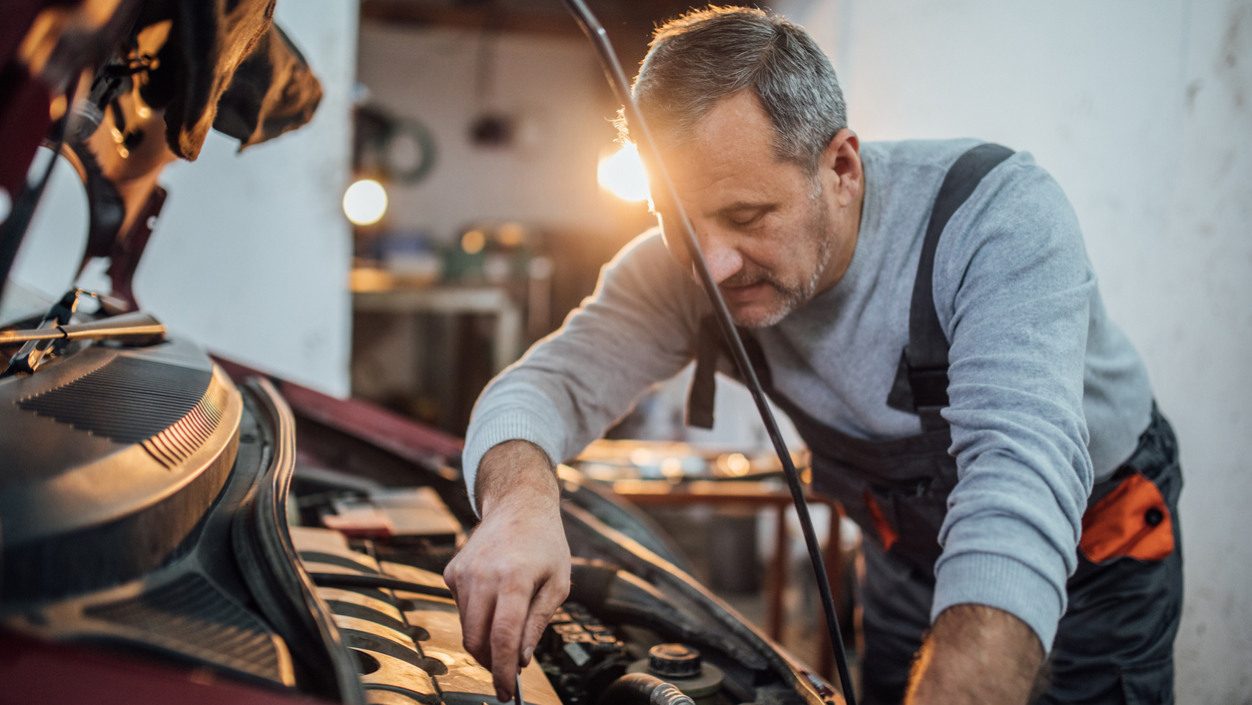Auto Mechanics and Asbestos
Mechanics who work with brakes, clutches and gaskets that contain asbestos are at risk of developing mesothelioma, asbestosis and asbestos lung cancer. Symptoms of these asbestos-related diseases may not appear for 20-60 years after a mechanic's initial exposure.

How Auto Mechanics Are Exposed to Asbestos
Hobbyists, do-it-yourselfers and professional mechanics alike can come into contact with asbestos when working on car parts. Asbestos is a heat-resistant mineral that was commonly used in car parts until the 1980s. It’s still present in many older cars and imported auto parts from countries that still actively use asbestos.
According to the American Journal of Epidemiology, 82% of auto mechanics are frequently exposed to asbestos. One study estimated 730,000 documented workers in the U.S. are at risk of asbestos exposure from brake repairs alone. Current estimates report millions of DIY mechanics are also at risk of asbestos exposure.
Drum and disc brakes used to be made with 35% to 60% asbestos. Most car makers stopped using asbestos in brake pads in the 1990s, but it’s still legal in the U.S. to sell aftermarket auto parts with asbestos. Many older brake and clutch parts may still have up to 35% asbestos. As a result, both professionals and DIYers are at an increased risk of developing mesothelioma.
Where Are Auto Mechanics Exposed to Asbestos?
Auto mechanics can be exposed to asbestos in auto parts that contain the toxic mineral. Hobbyists and auto mechanics working on older cars are especially at risk of developing an asbestos-related disease like mesothelioma. This is because older cars are more likely to contain asbestos parts than newer cars.
Asbestos Exposure Sites for Auto Mechanics
- Auto parts supply stores: Though less common, selling asbestos-containing auto parts is still legal. Auto mechanics may encounter such parts in supply stores.
- Home garages: Home garages, especially those of classic car collectors, pose a high risk of asbestos exposure for auto mechanics.
- Manufacturing plants: Auto factory workers were once commonly exposed to asbestos and could potentially still be at risk when assembling cars with imported auto parts.
- Repair shops: Repair shops see vehicles of all ages, some of which may be old enough to contain asbestos components.
- Truck stops: Some trucks still contain asbestos components that may be disturbed while an auto mechanic is doing repairs or maintenance.
- Train stations: Many older trains still use asbestos components, and mechanics may face exposure during maintenance.
Asbestos exposure poses an extreme threat to human health. Whether you deal with auto parts as a hobby or career, research and follow safety guidelines to avoid exposure.
Exercise extreme caution when working in any environment where you could risk asbestos exposure. Inhaling even a small amount of asbestos dust can be dangerous, so protecting yourself and others is essential.
Asbestos Products Auto Mechanics Handle in Cars
Mechanics who work on older cars may encounter asbestos-containing parts such as hoods, brakes and clutches. Contaminated parts can be in any vehicle, including cars, trucks, motorcycles, buses, trains and military vehicles.
Asbestos brakes and clutches were also present in elevators and other types of transportation machinery. It’s safest to assume older parts contain asbestos and exercise caution.
Car Parts That May Contain Asbestos
Though asbestos car parts are now much rarer, they were once unregulated. As a result, asbestos-containing car parts are still commonplace, and auto mechanics may continue to face exposure to asbestos fibers.
Some imported auto parts currently contain asbestos. The U.S. Geological Survey’s Mineral Commodity Summaries of January 2024 noted “the exhaust system of a specific type of utility vehicle” and “some vehicle friction products” imported into the U.S. as of 2020 were known to contain asbestos.

Learn about your diagnosis, top doctors and how to pay for treatment.
Get Your Free GuideManufacturers of Asbestos Auto Parts
Many companies stopped production of asbestos auto parts in the 1980s when the first asbestos regulations appeared. Following the Biden administration’s finalizing of the 2024 ban on using and importing chrysotile asbestos, many companies have started further phasing out asbestos products. However, other manufacturers continue to operate despite asbestos’ known carcinogenic properties.
Auto Part Manufacturers That Used Asbestos
Most of these businesses no longer manufacture auto parts that contain asbestos, but their sale is still legal. Workers and consumers may unwittingly purchase and use asbestos products from companies like Ford while working with used cars.
Many manufacturers, including General Motors, have filed for bankruptcy protection from asbestos lawsuits against their products. These companies typically set up trust funds to handle their lawsuits. If you were exposed to asbestos through these products, you may have asbestos compensation options.
Occupations at Risk of Asbestos in Cars
Workers at auto assembly plants, repair shops and supply stores were exposed to asbestos. Train stations, bus stations, truck stops and auto part manufacturing plants also exposed workers. Even toll road collectors face a higher risk of asbestos-related diseases from repeated exposure to asbestos in brakes.
Automotive Occupations at Risk of Asbestos Exposure
Danielle DiPietro, a Patient Advocate at The Mesothelioma Center, says, “It’s very common for mesothelioma patients to have at least some exposure that falls in the category of auto mechanic. However, a patient’s main occupation isn’t always an auto mechanic. I have found that many patients did some of their own auto work, especially changing brake pads.”
My father sold used auto parts. Then I became a mechanic in our household, disassembling cars I was in contact with asbestos in the clutches and brakes.
Auto Mechanics and Asbestos-Related Diseases
Because of their heavy, prolonged occupational exposure, auto mechanics are at a higher risk of developing diseases like pleural mesothelioma, lung cancer and asbestosis. Family members of auto mechanics are also at risk of secondary asbestos exposure from fibers being brought home accidentally.
Many mechanics deal with oil or grease while working. These fluids can stick to hands and clothes and asbestos fibers can stick to oils and grease. In this way, workers can bring home asbestos fibers. A mechanic’s family and household may then develop mesothelioma.
Early diagnosis is key to better outcomes for mesothelioma and other asbestos cancers. If you’re an auto mechanic or their loved one, speak with your doctor about your history of asbestos exposure. If you experience symptoms, seek a mesothelioma specialist as soon as possible.
Auto Shop and Home Mechanic Safety Measures to Reduce Asbestos Exposure
Fixing brakes or clutches can release harmful asbestos fibers, putting professional mechanics and DIYers at risk. The Occupational Safety and Health Administration and Environmental Protection Agency have created guidelines to help you avoid this danger. These safety steps are essential for protecting yourself, your workers and your family.
OSHA-Approved Methods for Professional Auto Shops
Professional mechanics must follow OSHA regulations to limit asbestos exposure, especially during brake and clutch repairs. OSHA endorses 3 primary methods, which vary based on the number of jobs a shop performs per week.
Managing Asbestos in Auto Shops
- Low-pressure/wet cleaning method: For shops performing more than 5 brake or clutch jobs weekly, low-pressure spray equipment wets the area, collecting runoff in a tray. The collected material should be properly disposed of afterward.
- Negative-pressure enclosure/HEPA vacuum method: An alternative for high-volume shops, attach a vacuum box to create an airtight seal around the brake or clutch, preventing asbestos dust from escaping. The vacuum must have a HEPA filter.
- Wet-wipe method: For shops doing 5 or fewer brake or clutch jobs weekly, spray a water-detergent mix onto the system and wipe it down with disposable rags. Then, dispose of the wipes as asbestos waste.
These methods, though dated, are still the most recent guidance from OSHA and the EPA. They remain effective in controlling asbestos exposure in professional settings.
EPA Best Practices for All Mechanics
The EPA’s Asbestos Worker Protection Rule offers additional recommendations that complement OSHA’s requirements. They apply to both professionals and home mechanics.
EPA-Recommended Asbestos Management
- Avoid blowing dust: Never use compressed air, dry rags or brushes to clean brake or clutch components. They can release asbestos fibers into the air.
- Enclosed or wet methods: Use either an enclosed HEPA vacuum system or a low-pressure wet method when proper equipment isn’t available.
- Limit exposure: Keep others out of the work area and never eat or drink near brake or clutch jobs.
- Use proper equipment: Always use a wet/dry vacuum with a HEPA filter. Standard vacuums or garden hoses aren’t safe.
Knowing about asbestos in car parts is important to reduce risks. Mechanics should wear protective gear like masks (tight-fitting respirators with HEPA filters, specifically P100 or equivalent) and gloves when handling materials that may contain asbestos and ensure good airflow.
Additional Guidelines for At-Home Mechanics
DIY mechanics aren’t legally required to follow EPA safety guidelines. However, the agency strongly encourages strict precautions.
Tips for Hobbyists and DIY Mechanics
- Protect your household: Don’t bring asbestos dust into your home. Set up a decontamination area outside and avoid reusing contaminated clothes. Dispose of them with asbestos waste.
- Buy safe parts: Use pre-ground, ready-to-install brake or clutch parts. Grinding asbestos parts makes them more friable and dangerous.
- Use the right tools: Ensure machinery has a HEPA filter and dust collection system.
- Dispose of waste properly: Wet all asbestos waste and double-bag it in 6-mil plastic bags. Place bags in a sealed, leak-tight container labeled as asbestos waste and bring them to a designated landfill.
Professional handling is always the best option, given the safety risks and legal requirements. DIY work and improper asbestos waste handling increase exposure risk and can harm landfill workers.

Get help finding a top attorney who can get you the compensation you deserve.
Get Help NowCompensation for Auto Workers Exposed to Asbestos
Auto workers exposed to asbestos may be eligible for compensation that can cover medical costs and lost wages. A mesothelioma attorney can help you file a legal claim against those responsible for your exposure. Treatment for asbestos-related conditions is costly, and funds obtained from a settlement can assist in covering these expenses.
Previous lawsuits have resulted in significant payouts for auto mechanics with successful claims. Millions of dollars have been awarded in a single settlement. In Arkansas, mechanic Ronald Burlie Thomas developed mesothelioma from asbestos exposure and died. His estate sued Honeywell International, winning an $18.5 million settlement in 2019.
Another case that’s still ongoing involves Susan Carboni, executor of Francesco Carboni’s estate. The estate is suing multiple companies after Francesco’s death from lung cancer after years of asbestos exposure while working as a mechanic.
Recommended Reading




